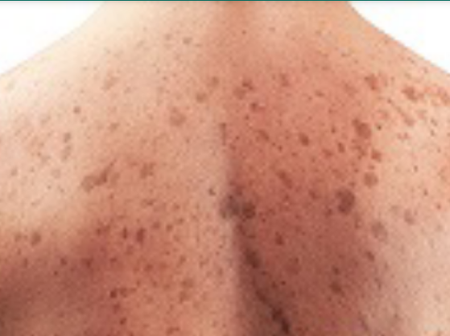
Skin cancer is a common and locally destructive cancerous (malignant) growth of the skin. It originates from the cells that line up along the membrane that separates the superficial layer of skin from the deeper layers.
Unlike cutaneous malignant melanoma, the vast majority of these sorts of skin cancers have a limited potential to spread to other parts of the body (metastasize) and become life-threatening.
Causes
a. Exposure to ultraviolet radiations
b. Exposure to radiation such as X-ray
c. Exposure to ionizing agents or chemicals such as arsenic
d. Certain drugs/ medications
e. As a complication of other diseases
Signs and Symptoms
i. Painless ulcer
ii. Crust or scab develop
iii. Periodic bleeding from the site
iv. Red spot on the skin
v. Itchy
NB: They are mainly found on the face, neck, bald scalps, arms, backs of hands and lower legs.
Preventions
1. Carefully select cosmetic products and contact lenses that offer ultraviolet protection
2. Avoid direct exposure to sunlight
3. Be a good role model (parents) and foster skin cancer prevention among the children
3. Wear sunglasses with ultraviolet protection
4. Regular self skin examination
Skin cancer: 10 spots

Avoid a lot of trouble by checking yourself for skin cancer every month
Skin cancer is one of the most common types of cancer, but it is also a type of cancer that can be effectively treated – but, it’s important to discover the symptoms at an early stage. By monthly checking your skin for suspicious spots or moles, you can prevent a lot of misery. A small side-note: make sure to check yourself from head to toe. So, don’t forget to check these 10 places.
1. Between your toes
Just check: do you ever apply sunscreen between your toes? Probably not. These areas are regularly unprotected from the sun in summer, and are therefore susceptible to skin cancer. Check for pink and flaky spots between your toes, as this may indicate skin cancer or melanoma. Take a photo and check if it is still there in a few weeks’ time.
2. In your ears
Your ears have uneven surfaces, nooks and crannies. Don’t only check your ear lobes but inspect your entire ear. Are there any strange bumps or any bleeding? Then keep an eye on this. Please get in touch with your doctor if these irregularities don’t heal.
3. Your eyes
Do you have growths or bumps around your eyes? Puffy eyelids or red eyes? Have your eyelashes suddenly started falling out? These can all be signs of skin cancer. Check your eyes for these symptoms every month. If the symptoms remain then it’s wise to pay a visit to your doctor.
4. Down under
Private parts are also susceptible to melanoma. Especially if you’re partial to visiting a solarium. In that case there is a good chance that you will be naked under ultraviolet radiation, so it is wise to regularly check things down there for strange spots or a general discoloration of the skin.
5. Your hands
Although you use and see your hands daily, it is advisable to take a good look at them once a month. Remove your nail polish (if you are wearing any) and check your nails for dark spots. Strange and unusual wounds next to your nails may also indicate a melanoma.
6. Under your breasts
One of the places that is often forgotten is under your breasts. Moles or pink and purple colored spots can be found here. You can check these spots by holding up a mirror. Keep this in mind and visit your doctor if you see any suspicious spots.
7. Your skull
It is difficult to check your own skull, so in this case ask your partner, family member, hairdresser or friend. There may be suspicious moles or spots on top of your head that may indicate skin cancer.
8. The soles of your feet
Another place you don’t look at every day: the soles of your feet. Although it is not common, there may be a melanoma on the sole of your foot. A bump or a strange blemish – which discolors, bleeds or itches – can be a sign that may indicate skin cancer.
9. Your tattoo
Do you have a tattoo? Check for changes every month. A strange bump or blemish can easily be hidden by your tattoo, so you won’t see this easily. Having some skin covered with a tattoo does not mean that skin cancer can’t develop there.
10. Check the inside of your mouth
Lie down once a month and open your mouth. Hold up a mirror and check your palate, tongue and the inside of your cheeks. Do you see striking, dark spots; or are there ulcers that still haven’t healed after three weeks? If so, this may indicate skin cancer. In particular, people who regularly light a cigarette can be prone to this.
